Risk Management and Corporate Governance at Golden Mining (ASX)
VerifiedAdded on 2019/09/23
|8
|3331
|393
Report
AI Summary
This report analyzes the application of ASX Corporate Governance Principles, specifically Principle 7 concerning risk management, within the context of Golden Mining Company. The analysis highlights the inadequacy of Golden's current approach and the need for a structured risk management framework. The report emphasizes the crucial role of the CFO, who also acts as Company Secretary, in implementing and overseeing these frameworks, adhering to the Australian Corporations Act and ASX listing rules. It details the responsibilities of the Board, the formation of a risk committee, and the importance of internal audits and disclosures regarding economic, environmental, and social sustainability risks. The report also outlines different types of risks (strategic, compliance, operational, financial, and reputational) that companies face, providing a comprehensive overview of corporate governance and risk management practices.
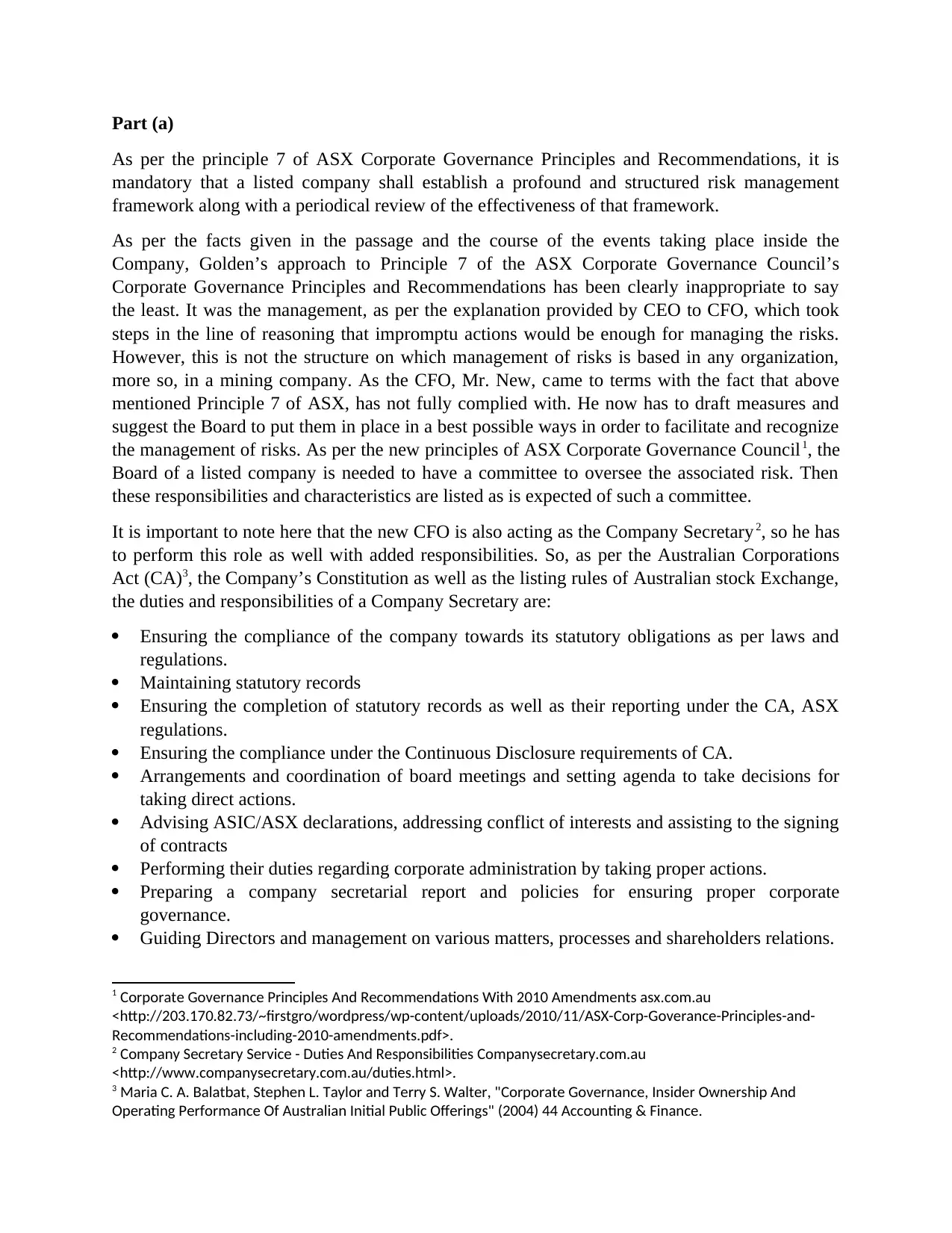
Part (a)
As per the principle 7 of ASX Corporate Governance Principles and Recommendations, it is
mandatory that a listed company shall establish a profound and structured risk management
framework along with a periodical review of the effectiveness of that framework.
As per the facts given in the passage and the course of the events taking place inside the
Company, Golden’s approach to Principle 7 of the ASX Corporate Governance Council’s
Corporate Governance Principles and Recommendations has been clearly inappropriate to say
the least. It was the management, as per the explanation provided by CEO to CFO, which took
steps in the line of reasoning that impromptu actions would be enough for managing the risks.
However, this is not the structure on which management of risks is based in any organization,
more so, in a mining company. As the CFO, Mr. New, came to terms with the fact that above
mentioned Principle 7 of ASX, has not fully complied with. He now has to draft measures and
suggest the Board to put them in place in a best possible ways in order to facilitate and recognize
the management of risks. As per the new principles of ASX Corporate Governance Council1, the
Board of a listed company is needed to have a committee to oversee the associated risk. Then
these responsibilities and characteristics are listed as is expected of such a committee.
It is important to note here that the new CFO is also acting as the Company Secretary 2, so he has
to perform this role as well with added responsibilities. So, as per the Australian Corporations
Act (CA)3, the Company’s Constitution as well as the listing rules of Australian stock Exchange,
the duties and responsibilities of a Company Secretary are:
Ensuring the compliance of the company towards its statutory obligations as per laws and
regulations.
Maintaining statutory records
Ensuring the completion of statutory records as well as their reporting under the CA, ASX
regulations.
Ensuring the compliance under the Continuous Disclosure requirements of CA.
Arrangements and coordination of board meetings and setting agenda to take decisions for
taking direct actions.
Advising ASIC/ASX declarations, addressing conflict of interests and assisting to the signing
of contracts
Performing their duties regarding corporate administration by taking proper actions.
Preparing a company secretarial report and policies for ensuring proper corporate
governance.
Guiding Directors and management on various matters, processes and shareholders relations.
1 Corporate Governance Principles And Recommendations With 2010 Amendments asx.com.au
<http://203.170.82.73/~firstgro/wordpress/wp-content/uploads/2010/11/ASX-Corp-Goverance-Principles-and-
Recommendations-including-2010-amendments.pdf>.
2 Company Secretary Service - Duties And Responsibilities Companysecretary.com.au
<http://www.companysecretary.com.au/duties.html>.
3 Maria C. A. Balatbat, Stephen L. Taylor and Terry S. Walter, "Corporate Governance, Insider Ownership And
Operating Performance Of Australian Initial Public Offerings" (2004) 44 Accounting & Finance.
As per the principle 7 of ASX Corporate Governance Principles and Recommendations, it is
mandatory that a listed company shall establish a profound and structured risk management
framework along with a periodical review of the effectiveness of that framework.
As per the facts given in the passage and the course of the events taking place inside the
Company, Golden’s approach to Principle 7 of the ASX Corporate Governance Council’s
Corporate Governance Principles and Recommendations has been clearly inappropriate to say
the least. It was the management, as per the explanation provided by CEO to CFO, which took
steps in the line of reasoning that impromptu actions would be enough for managing the risks.
However, this is not the structure on which management of risks is based in any organization,
more so, in a mining company. As the CFO, Mr. New, came to terms with the fact that above
mentioned Principle 7 of ASX, has not fully complied with. He now has to draft measures and
suggest the Board to put them in place in a best possible ways in order to facilitate and recognize
the management of risks. As per the new principles of ASX Corporate Governance Council1, the
Board of a listed company is needed to have a committee to oversee the associated risk. Then
these responsibilities and characteristics are listed as is expected of such a committee.
It is important to note here that the new CFO is also acting as the Company Secretary 2, so he has
to perform this role as well with added responsibilities. So, as per the Australian Corporations
Act (CA)3, the Company’s Constitution as well as the listing rules of Australian stock Exchange,
the duties and responsibilities of a Company Secretary are:
Ensuring the compliance of the company towards its statutory obligations as per laws and
regulations.
Maintaining statutory records
Ensuring the completion of statutory records as well as their reporting under the CA, ASX
regulations.
Ensuring the compliance under the Continuous Disclosure requirements of CA.
Arrangements and coordination of board meetings and setting agenda to take decisions for
taking direct actions.
Advising ASIC/ASX declarations, addressing conflict of interests and assisting to the signing
of contracts
Performing their duties regarding corporate administration by taking proper actions.
Preparing a company secretarial report and policies for ensuring proper corporate
governance.
Guiding Directors and management on various matters, processes and shareholders relations.
1 Corporate Governance Principles And Recommendations With 2010 Amendments asx.com.au
<http://203.170.82.73/~firstgro/wordpress/wp-content/uploads/2010/11/ASX-Corp-Goverance-Principles-and-
Recommendations-including-2010-amendments.pdf>.
2 Company Secretary Service - Duties And Responsibilities Companysecretary.com.au
<http://www.companysecretary.com.au/duties.html>.
3 Maria C. A. Balatbat, Stephen L. Taylor and Terry S. Walter, "Corporate Governance, Insider Ownership And
Operating Performance Of Australian Initial Public Offerings" (2004) 44 Accounting & Finance.
Paraphrase This Document
Need a fresh take? Get an instant paraphrase of this document with our AI Paraphraser
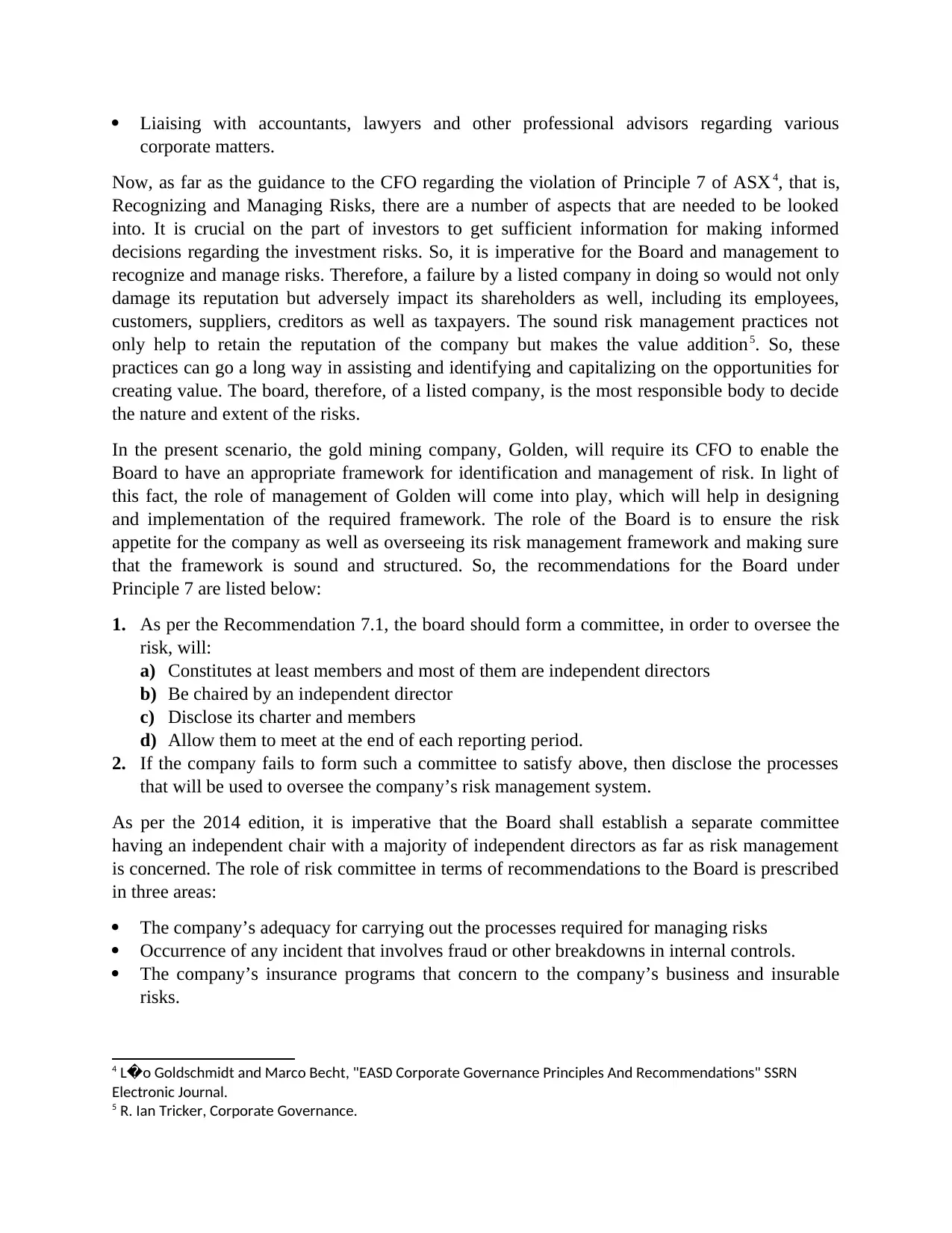
Liaising with accountants, lawyers and other professional advisors regarding various
corporate matters.
Now, as far as the guidance to the CFO regarding the violation of Principle 7 of ASX 4, that is,
Recognizing and Managing Risks, there are a number of aspects that are needed to be looked
into. It is crucial on the part of investors to get sufficient information for making informed
decisions regarding the investment risks. So, it is imperative for the Board and management to
recognize and manage risks. Therefore, a failure by a listed company in doing so would not only
damage its reputation but adversely impact its shareholders as well, including its employees,
customers, suppliers, creditors as well as taxpayers. The sound risk management practices not
only help to retain the reputation of the company but makes the value addition5. So, these
practices can go a long way in assisting and identifying and capitalizing on the opportunities for
creating value. The board, therefore, of a listed company, is the most responsible body to decide
the nature and extent of the risks.
In the present scenario, the gold mining company, Golden, will require its CFO to enable the
Board to have an appropriate framework for identification and management of risk. In light of
this fact, the role of management of Golden will come into play, which will help in designing
and implementation of the required framework. The role of the Board is to ensure the risk
appetite for the company as well as overseeing its risk management framework and making sure
that the framework is sound and structured. So, the recommendations for the Board under
Principle 7 are listed below:
1. As per the Recommendation 7.1, the board should form a committee, in order to oversee the
risk, will:
a) Constitutes at least members and most of them are independent directors
b) Be chaired by an independent director
c) Disclose its charter and members
d) Allow them to meet at the end of each reporting period.
2. If the company fails to form such a committee to satisfy above, then disclose the processes
that will be used to oversee the company’s risk management system.
As per the 2014 edition, it is imperative that the Board shall establish a separate committee
having an independent chair with a majority of independent directors as far as risk management
is concerned. The role of risk committee in terms of recommendations to the Board is prescribed
in three areas:
The company’s adequacy for carrying out the processes required for managing risks
Occurrence of any incident that involves fraud or other breakdowns in internal controls.
The company’s insurance programs that concern to the company’s business and insurable
risks.
4 L�o Goldschmidt and Marco Becht, "EASD Corporate Governance Principles And Recommendations" SSRN
Electronic Journal.
5 R. Ian Tricker, Corporate Governance.
corporate matters.
Now, as far as the guidance to the CFO regarding the violation of Principle 7 of ASX 4, that is,
Recognizing and Managing Risks, there are a number of aspects that are needed to be looked
into. It is crucial on the part of investors to get sufficient information for making informed
decisions regarding the investment risks. So, it is imperative for the Board and management to
recognize and manage risks. Therefore, a failure by a listed company in doing so would not only
damage its reputation but adversely impact its shareholders as well, including its employees,
customers, suppliers, creditors as well as taxpayers. The sound risk management practices not
only help to retain the reputation of the company but makes the value addition5. So, these
practices can go a long way in assisting and identifying and capitalizing on the opportunities for
creating value. The board, therefore, of a listed company, is the most responsible body to decide
the nature and extent of the risks.
In the present scenario, the gold mining company, Golden, will require its CFO to enable the
Board to have an appropriate framework for identification and management of risk. In light of
this fact, the role of management of Golden will come into play, which will help in designing
and implementation of the required framework. The role of the Board is to ensure the risk
appetite for the company as well as overseeing its risk management framework and making sure
that the framework is sound and structured. So, the recommendations for the Board under
Principle 7 are listed below:
1. As per the Recommendation 7.1, the board should form a committee, in order to oversee the
risk, will:
a) Constitutes at least members and most of them are independent directors
b) Be chaired by an independent director
c) Disclose its charter and members
d) Allow them to meet at the end of each reporting period.
2. If the company fails to form such a committee to satisfy above, then disclose the processes
that will be used to oversee the company’s risk management system.
As per the 2014 edition, it is imperative that the Board shall establish a separate committee
having an independent chair with a majority of independent directors as far as risk management
is concerned. The role of risk committee in terms of recommendations to the Board is prescribed
in three areas:
The company’s adequacy for carrying out the processes required for managing risks
Occurrence of any incident that involves fraud or other breakdowns in internal controls.
The company’s insurance programs that concern to the company’s business and insurable
risks.
4 L�o Goldschmidt and Marco Becht, "EASD Corporate Governance Principles And Recommendations" SSRN
Electronic Journal.
5 R. Ian Tricker, Corporate Governance.
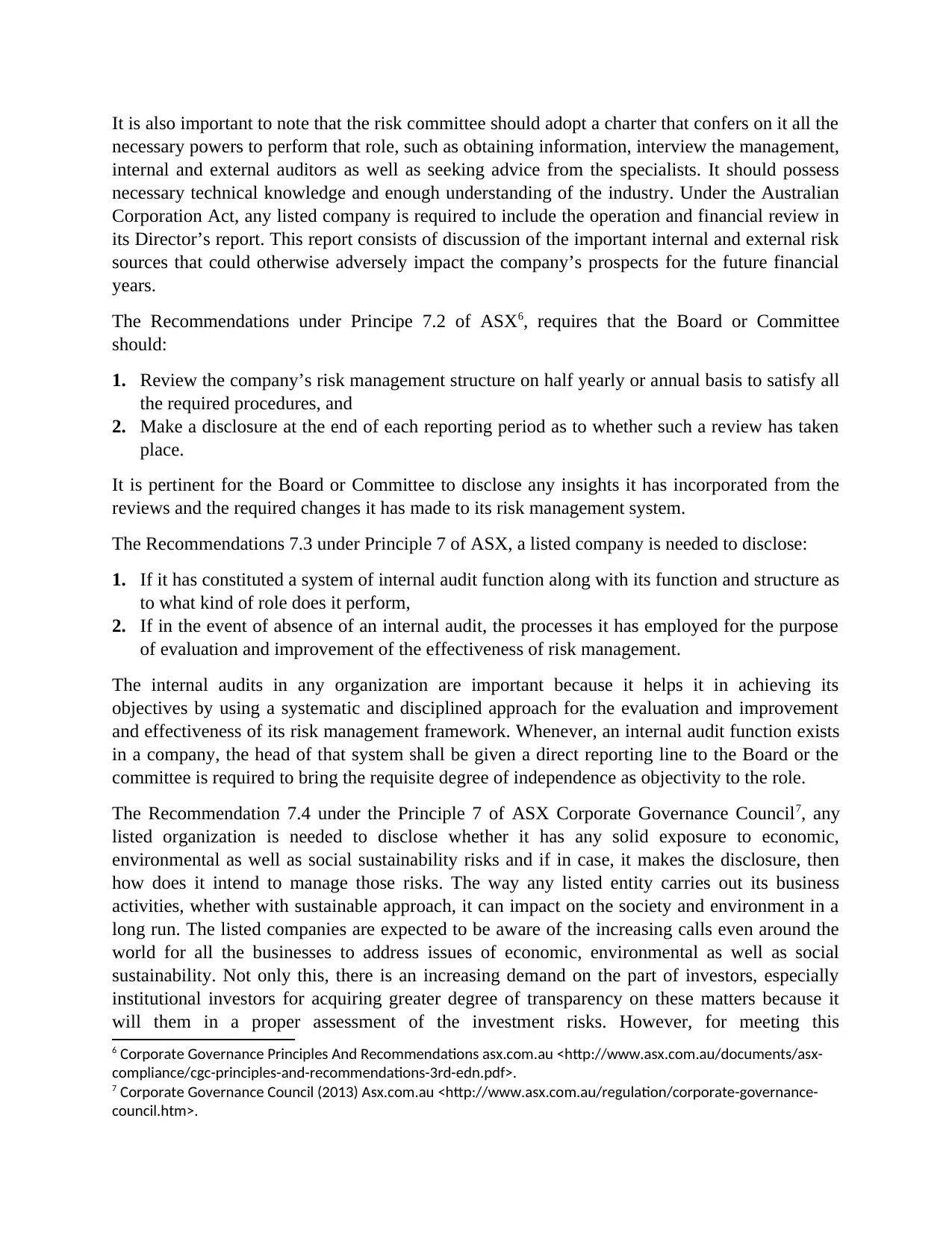
It is also important to note that the risk committee should adopt a charter that confers on it all the
necessary powers to perform that role, such as obtaining information, interview the management,
internal and external auditors as well as seeking advice from the specialists. It should possess
necessary technical knowledge and enough understanding of the industry. Under the Australian
Corporation Act, any listed company is required to include the operation and financial review in
its Director’s report. This report consists of discussion of the important internal and external risk
sources that could otherwise adversely impact the company’s prospects for the future financial
years.
The Recommendations under Principe 7.2 of ASX6, requires that the Board or Committee
should:
1. Review the company’s risk management structure on half yearly or annual basis to satisfy all
the required procedures, and
2. Make a disclosure at the end of each reporting period as to whether such a review has taken
place.
It is pertinent for the Board or Committee to disclose any insights it has incorporated from the
reviews and the required changes it has made to its risk management system.
The Recommendations 7.3 under Principle 7 of ASX, a listed company is needed to disclose:
1. If it has constituted a system of internal audit function along with its function and structure as
to what kind of role does it perform,
2. If in the event of absence of an internal audit, the processes it has employed for the purpose
of evaluation and improvement of the effectiveness of risk management.
The internal audits in any organization are important because it helps it in achieving its
objectives by using a systematic and disciplined approach for the evaluation and improvement
and effectiveness of its risk management framework. Whenever, an internal audit function exists
in a company, the head of that system shall be given a direct reporting line to the Board or the
committee is required to bring the requisite degree of independence as objectivity to the role.
The Recommendation 7.4 under the Principle 7 of ASX Corporate Governance Council7, any
listed organization is needed to disclose whether it has any solid exposure to economic,
environmental as well as social sustainability risks and if in case, it makes the disclosure, then
how does it intend to manage those risks. The way any listed entity carries out its business
activities, whether with sustainable approach, it can impact on the society and environment in a
long run. The listed companies are expected to be aware of the increasing calls even around the
world for all the businesses to address issues of economic, environmental as well as social
sustainability. Not only this, there is an increasing demand on the part of investors, especially
institutional investors for acquiring greater degree of transparency on these matters because it
will them in a proper assessment of the investment risks. However, for meeting this
6 Corporate Governance Principles And Recommendations asx.com.au <http://www.asx.com.au/documents/asx-
compliance/cgc-principles-and-recommendations-3rd-edn.pdf>.
7 Corporate Governance Council (2013) Asx.com.au <http://www.asx.com.au/regulation/corporate-governance-
council.htm>.
necessary powers to perform that role, such as obtaining information, interview the management,
internal and external auditors as well as seeking advice from the specialists. It should possess
necessary technical knowledge and enough understanding of the industry. Under the Australian
Corporation Act, any listed company is required to include the operation and financial review in
its Director’s report. This report consists of discussion of the important internal and external risk
sources that could otherwise adversely impact the company’s prospects for the future financial
years.
The Recommendations under Principe 7.2 of ASX6, requires that the Board or Committee
should:
1. Review the company’s risk management structure on half yearly or annual basis to satisfy all
the required procedures, and
2. Make a disclosure at the end of each reporting period as to whether such a review has taken
place.
It is pertinent for the Board or Committee to disclose any insights it has incorporated from the
reviews and the required changes it has made to its risk management system.
The Recommendations 7.3 under Principle 7 of ASX, a listed company is needed to disclose:
1. If it has constituted a system of internal audit function along with its function and structure as
to what kind of role does it perform,
2. If in the event of absence of an internal audit, the processes it has employed for the purpose
of evaluation and improvement of the effectiveness of risk management.
The internal audits in any organization are important because it helps it in achieving its
objectives by using a systematic and disciplined approach for the evaluation and improvement
and effectiveness of its risk management framework. Whenever, an internal audit function exists
in a company, the head of that system shall be given a direct reporting line to the Board or the
committee is required to bring the requisite degree of independence as objectivity to the role.
The Recommendation 7.4 under the Principle 7 of ASX Corporate Governance Council7, any
listed organization is needed to disclose whether it has any solid exposure to economic,
environmental as well as social sustainability risks and if in case, it makes the disclosure, then
how does it intend to manage those risks. The way any listed entity carries out its business
activities, whether with sustainable approach, it can impact on the society and environment in a
long run. The listed companies are expected to be aware of the increasing calls even around the
world for all the businesses to address issues of economic, environmental as well as social
sustainability. Not only this, there is an increasing demand on the part of investors, especially
institutional investors for acquiring greater degree of transparency on these matters because it
will them in a proper assessment of the investment risks. However, for meeting this
6 Corporate Governance Principles And Recommendations asx.com.au <http://www.asx.com.au/documents/asx-
compliance/cgc-principles-and-recommendations-3rd-edn.pdf>.
7 Corporate Governance Council (2013) Asx.com.au <http://www.asx.com.au/regulation/corporate-governance-
council.htm>.
⊘ This is a preview!⊘
Do you want full access?
Subscribe today to unlock all pages.

Trusted by 1+ million students worldwide
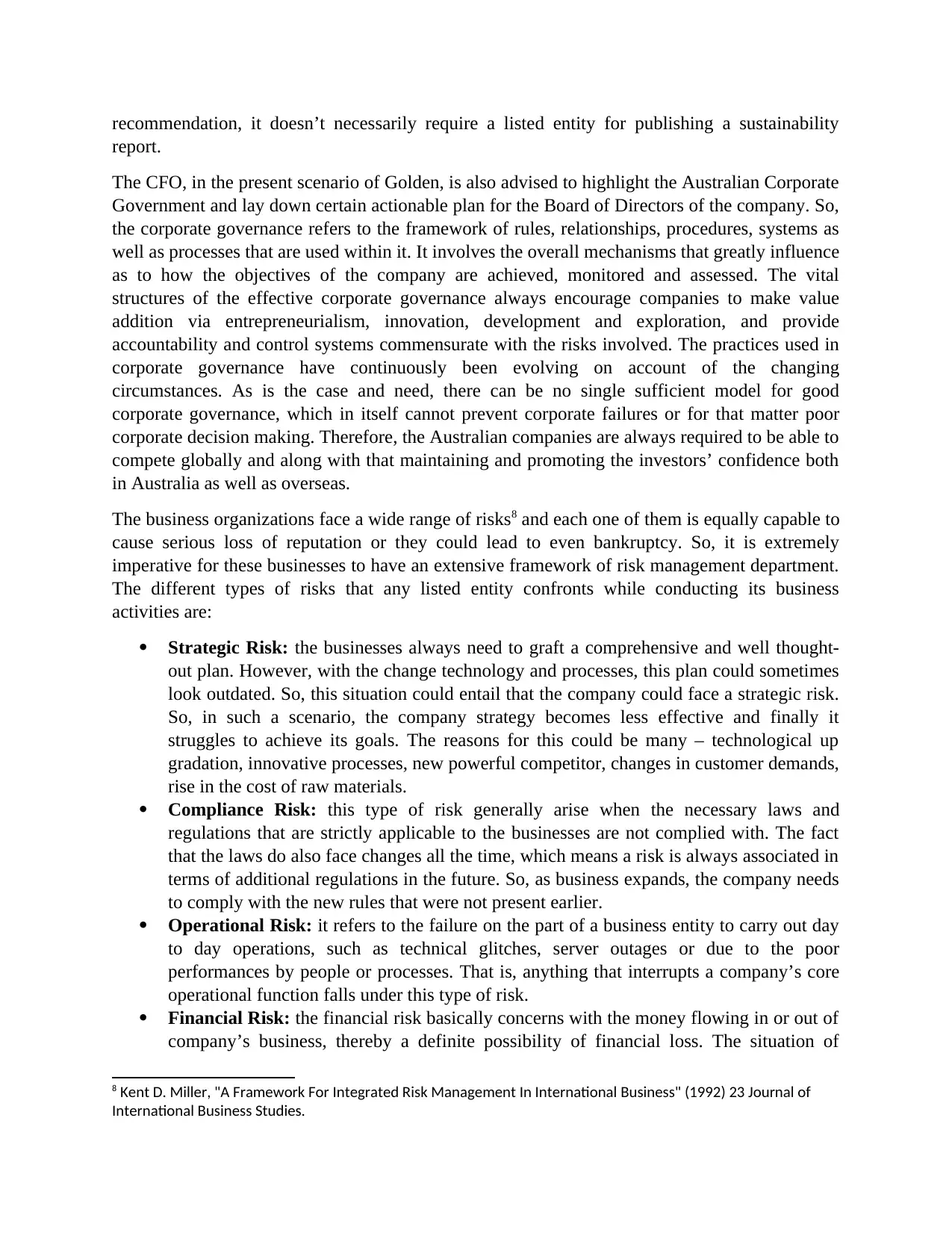
recommendation, it doesn’t necessarily require a listed entity for publishing a sustainability
report.
The CFO, in the present scenario of Golden, is also advised to highlight the Australian Corporate
Government and lay down certain actionable plan for the Board of Directors of the company. So,
the corporate governance refers to the framework of rules, relationships, procedures, systems as
well as processes that are used within it. It involves the overall mechanisms that greatly influence
as to how the objectives of the company are achieved, monitored and assessed. The vital
structures of the effective corporate governance always encourage companies to make value
addition via entrepreneurialism, innovation, development and exploration, and provide
accountability and control systems commensurate with the risks involved. The practices used in
corporate governance have continuously been evolving on account of the changing
circumstances. As is the case and need, there can be no single sufficient model for good
corporate governance, which in itself cannot prevent corporate failures or for that matter poor
corporate decision making. Therefore, the Australian companies are always required to be able to
compete globally and along with that maintaining and promoting the investors’ confidence both
in Australia as well as overseas.
The business organizations face a wide range of risks8 and each one of them is equally capable to
cause serious loss of reputation or they could lead to even bankruptcy. So, it is extremely
imperative for these businesses to have an extensive framework of risk management department.
The different types of risks that any listed entity confronts while conducting its business
activities are:
Strategic Risk: the businesses always need to graft a comprehensive and well thought-
out plan. However, with the change technology and processes, this plan could sometimes
look outdated. So, this situation could entail that the company could face a strategic risk.
So, in such a scenario, the company strategy becomes less effective and finally it
struggles to achieve its goals. The reasons for this could be many – technological up
gradation, innovative processes, new powerful competitor, changes in customer demands,
rise in the cost of raw materials.
Compliance Risk: this type of risk generally arise when the necessary laws and
regulations that are strictly applicable to the businesses are not complied with. The fact
that the laws do also face changes all the time, which means a risk is always associated in
terms of additional regulations in the future. So, as business expands, the company needs
to comply with the new rules that were not present earlier.
Operational Risk: it refers to the failure on the part of a business entity to carry out day
to day operations, such as technical glitches, server outages or due to the poor
performances by people or processes. That is, anything that interrupts a company’s core
operational function falls under this type of risk.
Financial Risk: the financial risk basically concerns with the money flowing in or out of
company’s business, thereby a definite possibility of financial loss. The situation of
8 Kent D. Miller, "A Framework For Integrated Risk Management In International Business" (1992) 23 Journal of
International Business Studies.
report.
The CFO, in the present scenario of Golden, is also advised to highlight the Australian Corporate
Government and lay down certain actionable plan for the Board of Directors of the company. So,
the corporate governance refers to the framework of rules, relationships, procedures, systems as
well as processes that are used within it. It involves the overall mechanisms that greatly influence
as to how the objectives of the company are achieved, monitored and assessed. The vital
structures of the effective corporate governance always encourage companies to make value
addition via entrepreneurialism, innovation, development and exploration, and provide
accountability and control systems commensurate with the risks involved. The practices used in
corporate governance have continuously been evolving on account of the changing
circumstances. As is the case and need, there can be no single sufficient model for good
corporate governance, which in itself cannot prevent corporate failures or for that matter poor
corporate decision making. Therefore, the Australian companies are always required to be able to
compete globally and along with that maintaining and promoting the investors’ confidence both
in Australia as well as overseas.
The business organizations face a wide range of risks8 and each one of them is equally capable to
cause serious loss of reputation or they could lead to even bankruptcy. So, it is extremely
imperative for these businesses to have an extensive framework of risk management department.
The different types of risks that any listed entity confronts while conducting its business
activities are:
Strategic Risk: the businesses always need to graft a comprehensive and well thought-
out plan. However, with the change technology and processes, this plan could sometimes
look outdated. So, this situation could entail that the company could face a strategic risk.
So, in such a scenario, the company strategy becomes less effective and finally it
struggles to achieve its goals. The reasons for this could be many – technological up
gradation, innovative processes, new powerful competitor, changes in customer demands,
rise in the cost of raw materials.
Compliance Risk: this type of risk generally arise when the necessary laws and
regulations that are strictly applicable to the businesses are not complied with. The fact
that the laws do also face changes all the time, which means a risk is always associated in
terms of additional regulations in the future. So, as business expands, the company needs
to comply with the new rules that were not present earlier.
Operational Risk: it refers to the failure on the part of a business entity to carry out day
to day operations, such as technical glitches, server outages or due to the poor
performances by people or processes. That is, anything that interrupts a company’s core
operational function falls under this type of risk.
Financial Risk: the financial risk basically concerns with the money flowing in or out of
company’s business, thereby a definite possibility of financial loss. The situation of
8 Kent D. Miller, "A Framework For Integrated Risk Management In International Business" (1992) 23 Journal of
International Business Studies.
Paraphrase This Document
Need a fresh take? Get an instant paraphrase of this document with our AI Paraphraser
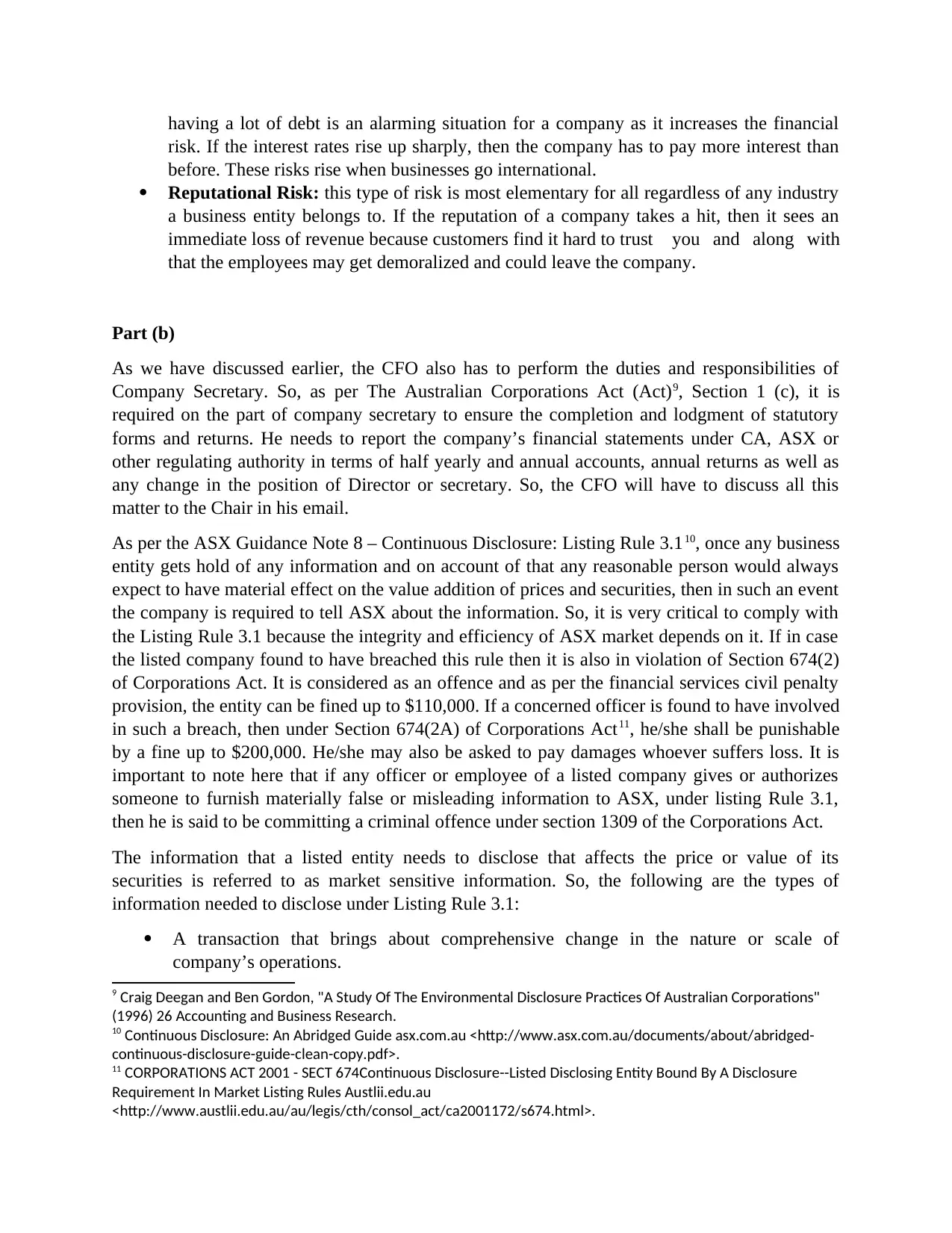
having a lot of debt is an alarming situation for a company as it increases the financial
risk. If the interest rates rise up sharply, then the company has to pay more interest than
before. These risks rise when businesses go international.
Reputational Risk: this type of risk is most elementary for all regardless of any industry
a business entity belongs to. If the reputation of a company takes a hit, then it sees an
immediate loss of revenue because customers find it hard to trust you and along with
that the employees may get demoralized and could leave the company.
Part (b)
As we have discussed earlier, the CFO also has to perform the duties and responsibilities of
Company Secretary. So, as per The Australian Corporations Act (Act)9, Section 1 (c), it is
required on the part of company secretary to ensure the completion and lodgment of statutory
forms and returns. He needs to report the company’s financial statements under CA, ASX or
other regulating authority in terms of half yearly and annual accounts, annual returns as well as
any change in the position of Director or secretary. So, the CFO will have to discuss all this
matter to the Chair in his email.
As per the ASX Guidance Note 8 – Continuous Disclosure: Listing Rule 3.110, once any business
entity gets hold of any information and on account of that any reasonable person would always
expect to have material effect on the value addition of prices and securities, then in such an event
the company is required to tell ASX about the information. So, it is very critical to comply with
the Listing Rule 3.1 because the integrity and efficiency of ASX market depends on it. If in case
the listed company found to have breached this rule then it is also in violation of Section 674(2)
of Corporations Act. It is considered as an offence and as per the financial services civil penalty
provision, the entity can be fined up to $110,000. If a concerned officer is found to have involved
in such a breach, then under Section 674(2A) of Corporations Act11, he/she shall be punishable
by a fine up to $200,000. He/she may also be asked to pay damages whoever suffers loss. It is
important to note here that if any officer or employee of a listed company gives or authorizes
someone to furnish materially false or misleading information to ASX, under listing Rule 3.1,
then he is said to be committing a criminal offence under section 1309 of the Corporations Act.
The information that a listed entity needs to disclose that affects the price or value of its
securities is referred to as market sensitive information. So, the following are the types of
information needed to disclose under Listing Rule 3.1:
A transaction that brings about comprehensive change in the nature or scale of
company’s operations.
9 Craig Deegan and Ben Gordon, "A Study Of The Environmental Disclosure Practices Of Australian Corporations"
(1996) 26 Accounting and Business Research.
10 Continuous Disclosure: An Abridged Guide asx.com.au <http://www.asx.com.au/documents/about/abridged-
continuous-disclosure-guide-clean-copy.pdf>.
11 CORPORATIONS ACT 2001 - SECT 674Continuous Disclosure--Listed Disclosing Entity Bound By A Disclosure
Requirement In Market Listing Rules Austlii.edu.au
<http://www.austlii.edu.au/au/legis/cth/consol_act/ca2001172/s674.html>.
risk. If the interest rates rise up sharply, then the company has to pay more interest than
before. These risks rise when businesses go international.
Reputational Risk: this type of risk is most elementary for all regardless of any industry
a business entity belongs to. If the reputation of a company takes a hit, then it sees an
immediate loss of revenue because customers find it hard to trust you and along with
that the employees may get demoralized and could leave the company.
Part (b)
As we have discussed earlier, the CFO also has to perform the duties and responsibilities of
Company Secretary. So, as per The Australian Corporations Act (Act)9, Section 1 (c), it is
required on the part of company secretary to ensure the completion and lodgment of statutory
forms and returns. He needs to report the company’s financial statements under CA, ASX or
other regulating authority in terms of half yearly and annual accounts, annual returns as well as
any change in the position of Director or secretary. So, the CFO will have to discuss all this
matter to the Chair in his email.
As per the ASX Guidance Note 8 – Continuous Disclosure: Listing Rule 3.110, once any business
entity gets hold of any information and on account of that any reasonable person would always
expect to have material effect on the value addition of prices and securities, then in such an event
the company is required to tell ASX about the information. So, it is very critical to comply with
the Listing Rule 3.1 because the integrity and efficiency of ASX market depends on it. If in case
the listed company found to have breached this rule then it is also in violation of Section 674(2)
of Corporations Act. It is considered as an offence and as per the financial services civil penalty
provision, the entity can be fined up to $110,000. If a concerned officer is found to have involved
in such a breach, then under Section 674(2A) of Corporations Act11, he/she shall be punishable
by a fine up to $200,000. He/she may also be asked to pay damages whoever suffers loss. It is
important to note here that if any officer or employee of a listed company gives or authorizes
someone to furnish materially false or misleading information to ASX, under listing Rule 3.1,
then he is said to be committing a criminal offence under section 1309 of the Corporations Act.
The information that a listed entity needs to disclose that affects the price or value of its
securities is referred to as market sensitive information. So, the following are the types of
information needed to disclose under Listing Rule 3.1:
A transaction that brings about comprehensive change in the nature or scale of
company’s operations.
9 Craig Deegan and Ben Gordon, "A Study Of The Environmental Disclosure Practices Of Australian Corporations"
(1996) 26 Accounting and Business Research.
10 Continuous Disclosure: An Abridged Guide asx.com.au <http://www.asx.com.au/documents/about/abridged-
continuous-disclosure-guide-clean-copy.pdf>.
11 CORPORATIONS ACT 2001 - SECT 674Continuous Disclosure--Listed Disclosing Entity Bound By A Disclosure
Requirement In Market Listing Rules Austlii.edu.au
<http://www.austlii.edu.au/au/legis/cth/consol_act/ca2001172/s674.html>.
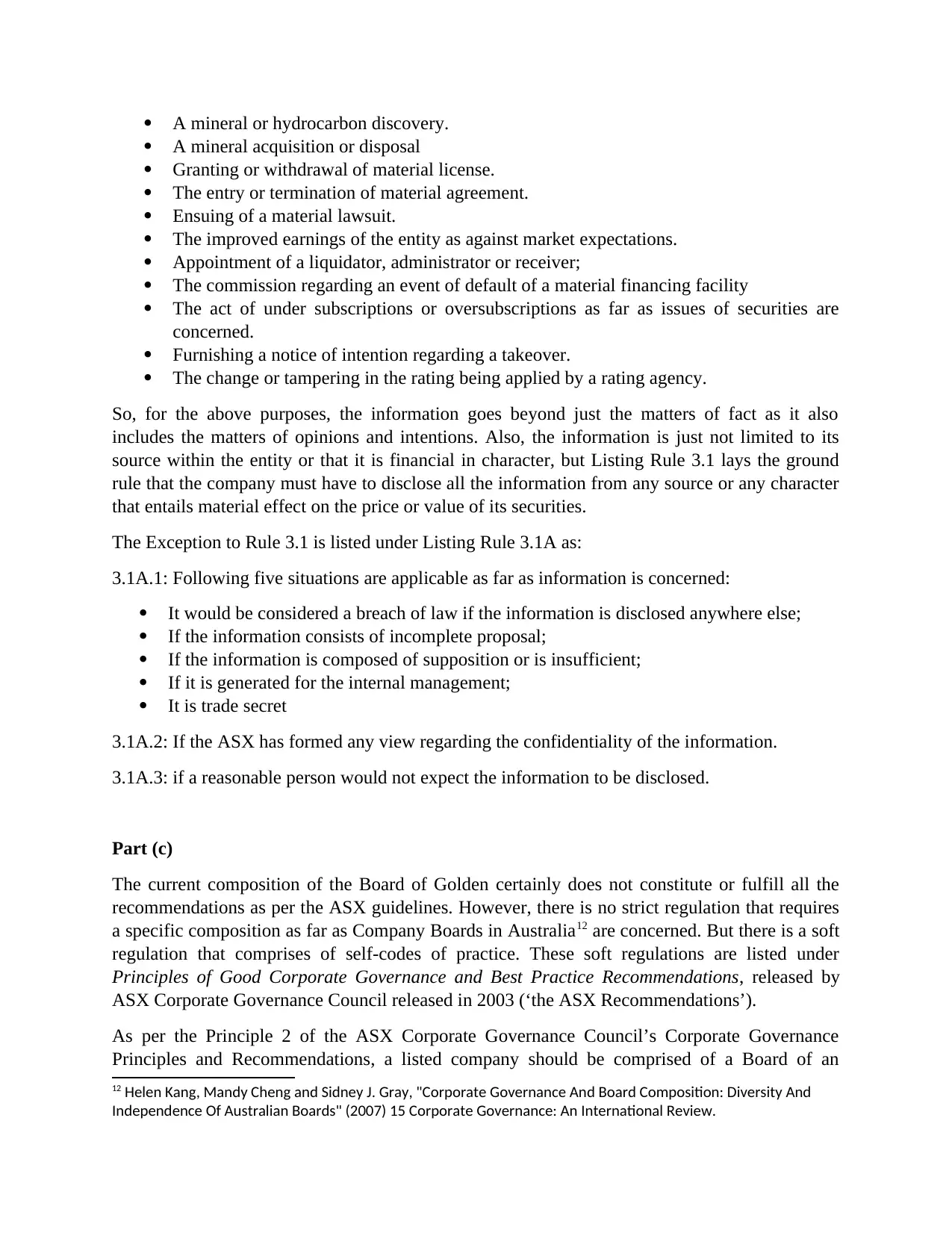
A mineral or hydrocarbon discovery.
A mineral acquisition or disposal
Granting or withdrawal of material license.
The entry or termination of material agreement.
Ensuing of a material lawsuit.
The improved earnings of the entity as against market expectations.
Appointment of a liquidator, administrator or receiver;
The commission regarding an event of default of a material financing facility
The act of under subscriptions or oversubscriptions as far as issues of securities are
concerned.
Furnishing a notice of intention regarding a takeover.
The change or tampering in the rating being applied by a rating agency.
So, for the above purposes, the information goes beyond just the matters of fact as it also
includes the matters of opinions and intentions. Also, the information is just not limited to its
source within the entity or that it is financial in character, but Listing Rule 3.1 lays the ground
rule that the company must have to disclose all the information from any source or any character
that entails material effect on the price or value of its securities.
The Exception to Rule 3.1 is listed under Listing Rule 3.1A as:
3.1A.1: Following five situations are applicable as far as information is concerned:
It would be considered a breach of law if the information is disclosed anywhere else;
If the information consists of incomplete proposal;
If the information is composed of supposition or is insufficient;
If it is generated for the internal management;
It is trade secret
3.1A.2: If the ASX has formed any view regarding the confidentiality of the information.
3.1A.3: if a reasonable person would not expect the information to be disclosed.
Part (c)
The current composition of the Board of Golden certainly does not constitute or fulfill all the
recommendations as per the ASX guidelines. However, there is no strict regulation that requires
a specific composition as far as Company Boards in Australia12 are concerned. But there is a soft
regulation that comprises of self-codes of practice. These soft regulations are listed under
Principles of Good Corporate Governance and Best Practice Recommendations, released by
ASX Corporate Governance Council released in 2003 (‘the ASX Recommendations’).
As per the Principle 2 of the ASX Corporate Governance Council’s Corporate Governance
Principles and Recommendations, a listed company should be comprised of a Board of an
12 Helen Kang, Mandy Cheng and Sidney J. Gray, "Corporate Governance And Board Composition: Diversity And
Independence Of Australian Boards" (2007) 15 Corporate Governance: An International Review.
A mineral acquisition or disposal
Granting or withdrawal of material license.
The entry or termination of material agreement.
Ensuing of a material lawsuit.
The improved earnings of the entity as against market expectations.
Appointment of a liquidator, administrator or receiver;
The commission regarding an event of default of a material financing facility
The act of under subscriptions or oversubscriptions as far as issues of securities are
concerned.
Furnishing a notice of intention regarding a takeover.
The change or tampering in the rating being applied by a rating agency.
So, for the above purposes, the information goes beyond just the matters of fact as it also
includes the matters of opinions and intentions. Also, the information is just not limited to its
source within the entity or that it is financial in character, but Listing Rule 3.1 lays the ground
rule that the company must have to disclose all the information from any source or any character
that entails material effect on the price or value of its securities.
The Exception to Rule 3.1 is listed under Listing Rule 3.1A as:
3.1A.1: Following five situations are applicable as far as information is concerned:
It would be considered a breach of law if the information is disclosed anywhere else;
If the information consists of incomplete proposal;
If the information is composed of supposition or is insufficient;
If it is generated for the internal management;
It is trade secret
3.1A.2: If the ASX has formed any view regarding the confidentiality of the information.
3.1A.3: if a reasonable person would not expect the information to be disclosed.
Part (c)
The current composition of the Board of Golden certainly does not constitute or fulfill all the
recommendations as per the ASX guidelines. However, there is no strict regulation that requires
a specific composition as far as Company Boards in Australia12 are concerned. But there is a soft
regulation that comprises of self-codes of practice. These soft regulations are listed under
Principles of Good Corporate Governance and Best Practice Recommendations, released by
ASX Corporate Governance Council released in 2003 (‘the ASX Recommendations’).
As per the Principle 2 of the ASX Corporate Governance Council’s Corporate Governance
Principles and Recommendations, a listed company should be comprised of a Board of an
12 Helen Kang, Mandy Cheng and Sidney J. Gray, "Corporate Governance And Board Composition: Diversity And
Independence Of Australian Boards" (2007) 15 Corporate Governance: An International Review.
⊘ This is a preview!⊘
Do you want full access?
Subscribe today to unlock all pages.

Trusted by 1+ million students worldwide
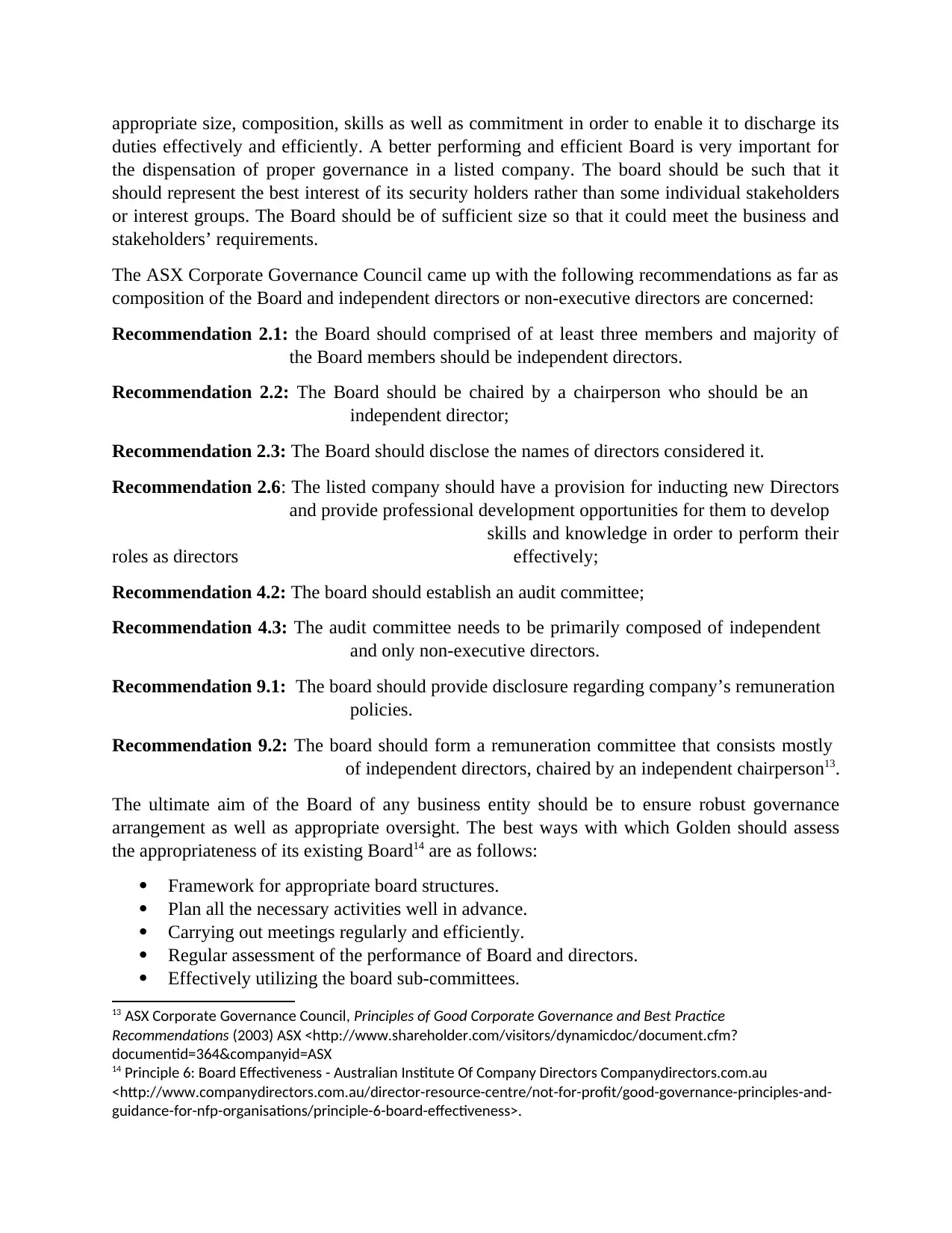
appropriate size, composition, skills as well as commitment in order to enable it to discharge its
duties effectively and efficiently. A better performing and efficient Board is very important for
the dispensation of proper governance in a listed company. The board should be such that it
should represent the best interest of its security holders rather than some individual stakeholders
or interest groups. The Board should be of sufficient size so that it could meet the business and
stakeholders’ requirements.
The ASX Corporate Governance Council came up with the following recommendations as far as
composition of the Board and independent directors or non-executive directors are concerned:
Recommendation 2.1: the Board should comprised of at least three members and majority of
the Board members should be independent directors.
Recommendation 2.2: The Board should be chaired by a chairperson who should be an
independent director;
Recommendation 2.3: The Board should disclose the names of directors considered it.
Recommendation 2.6: The listed company should have a provision for inducting new Directors
and provide professional development opportunities for them to develop
skills and knowledge in order to perform their
roles as directors effectively;
Recommendation 4.2: The board should establish an audit committee;
Recommendation 4.3: The audit committee needs to be primarily composed of independent
and only non-executive directors.
Recommendation 9.1: The board should provide disclosure regarding company’s remuneration
policies.
Recommendation 9.2: The board should form a remuneration committee that consists mostly
of independent directors, chaired by an independent chairperson13.
The ultimate aim of the Board of any business entity should be to ensure robust governance
arrangement as well as appropriate oversight. The best ways with which Golden should assess
the appropriateness of its existing Board14 are as follows:
Framework for appropriate board structures.
Plan all the necessary activities well in advance.
Carrying out meetings regularly and efficiently.
Regular assessment of the performance of Board and directors.
Effectively utilizing the board sub-committees.
13 ASX Corporate Governance Council, Principles of Good Corporate Governance and Best Practice
Recommendations (2003) ASX <http://www.shareholder.com/visitors/dynamicdoc/document.cfm?
documentid=364&companyid=ASX
14 Principle 6: Board Effectiveness - Australian Institute Of Company Directors Companydirectors.com.au
<http://www.companydirectors.com.au/director-resource-centre/not-for-profit/good-governance-principles-and-
guidance-for-nfp-organisations/principle-6-board-effectiveness>.
duties effectively and efficiently. A better performing and efficient Board is very important for
the dispensation of proper governance in a listed company. The board should be such that it
should represent the best interest of its security holders rather than some individual stakeholders
or interest groups. The Board should be of sufficient size so that it could meet the business and
stakeholders’ requirements.
The ASX Corporate Governance Council came up with the following recommendations as far as
composition of the Board and independent directors or non-executive directors are concerned:
Recommendation 2.1: the Board should comprised of at least three members and majority of
the Board members should be independent directors.
Recommendation 2.2: The Board should be chaired by a chairperson who should be an
independent director;
Recommendation 2.3: The Board should disclose the names of directors considered it.
Recommendation 2.6: The listed company should have a provision for inducting new Directors
and provide professional development opportunities for them to develop
skills and knowledge in order to perform their
roles as directors effectively;
Recommendation 4.2: The board should establish an audit committee;
Recommendation 4.3: The audit committee needs to be primarily composed of independent
and only non-executive directors.
Recommendation 9.1: The board should provide disclosure regarding company’s remuneration
policies.
Recommendation 9.2: The board should form a remuneration committee that consists mostly
of independent directors, chaired by an independent chairperson13.
The ultimate aim of the Board of any business entity should be to ensure robust governance
arrangement as well as appropriate oversight. The best ways with which Golden should assess
the appropriateness of its existing Board14 are as follows:
Framework for appropriate board structures.
Plan all the necessary activities well in advance.
Carrying out meetings regularly and efficiently.
Regular assessment of the performance of Board and directors.
Effectively utilizing the board sub-committees.
13 ASX Corporate Governance Council, Principles of Good Corporate Governance and Best Practice
Recommendations (2003) ASX <http://www.shareholder.com/visitors/dynamicdoc/document.cfm?
documentid=364&companyid=ASX
14 Principle 6: Board Effectiveness - Australian Institute Of Company Directors Companydirectors.com.au
<http://www.companydirectors.com.au/director-resource-centre/not-for-profit/good-governance-principles-and-
guidance-for-nfp-organisations/principle-6-board-effectiveness>.
Paraphrase This Document
Need a fresh take? Get an instant paraphrase of this document with our AI Paraphraser

Planning of Board succession.
1 out of 8
Related Documents
Your All-in-One AI-Powered Toolkit for Academic Success.
+13062052269
info@desklib.com
Available 24*7 on WhatsApp / Email
![[object Object]](/_next/static/media/star-bottom.7253800d.svg)
Unlock your academic potential
Copyright © 2020–2025 A2Z Services. All Rights Reserved. Developed and managed by ZUCOL.




